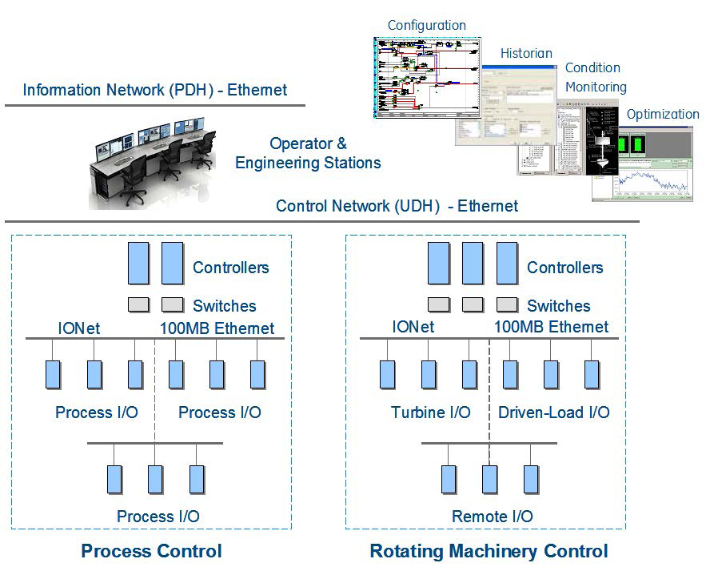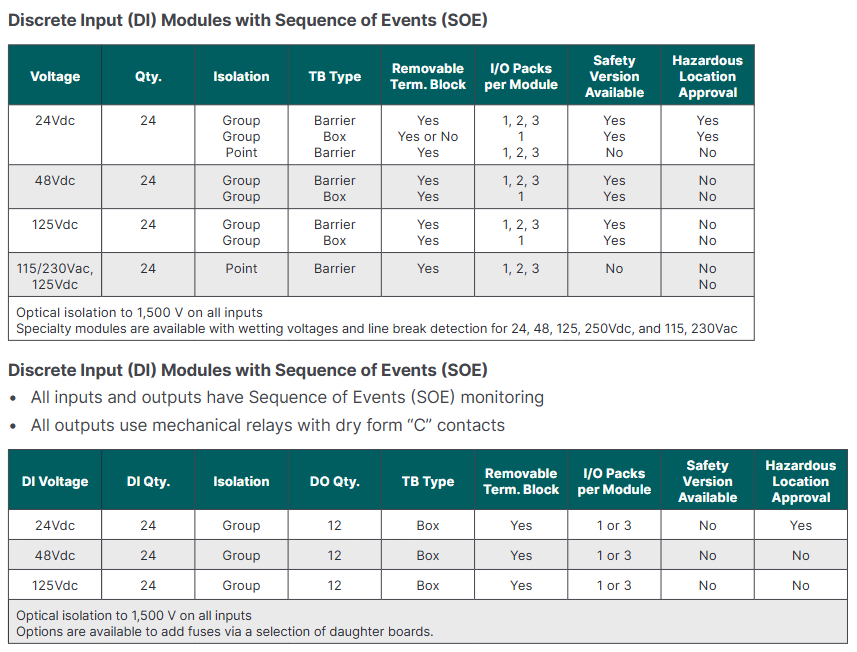

K-WANG


GE Mark VIe Control System
GE Mark VIe Control System
Introduction
The Mark VIe control system is a flexible platform suitable for various application scenarios, with high-speed networked input/output (I/O) functionality, supporting simplex, dual, and triple redundant systems. It adopts industry standard Ethernet communication for connecting I/O, controllers, operators and maintenance stations, as well as third-party systems. The ControlST software suite (including the ToolboxST toolset) is used for programming, configuration, trend analysis, and diagnostics of the system, providing high-quality, time consistent data at the controller and factory levels to assist in effective management of control system equipment. In addition, the Mark VIeS safety control is an independent safety control system suitable for safety critical applications that comply with the IEC 61508 standard. It also uses the ControlST software suite to simplify maintenance, but has unique certified hardware and software modules.

System Overview
Core components: With a single board controller as the core, it includes a main processor, redundant Ethernet drivers for communicating with networked I/O, and additional Ethernet drivers for controlling the network. The main processor and I/O modules adopt a real-time multitasking operating system, and the control software is stored in non-volatile memory in a configurable control block language. It also supports IEEE 854 32-bit floating-point format and Sequential Function Chart (SFC).
I/O Network (IONet): It is a dedicated full duplex point-to-point protocol that provides a deterministic high-speed 100MB communication network, suitable for local or distributed I/O devices, supports single, dual, and triple redundancy configurations, and also supports copper and fiber optic interfaces.
I/O module: It consists of three parts: terminal board, terminal block, and I/O package. There are two types of terminal boards: T-type and S-type. T-type usually assigns inputs to three independent I/O packs, while S-type provides a set of screws for each I/O point. The I/O packet contains two Ethernet ports, a power supply, a local processor, and a data acquisition board, which can be added according to application requirements to expand I/O capabilities. It supports simplex, dual, or triple redundant configurations.

Redundant configuration: Provides multiple redundancy options for processes with different levels of criticality, involving multiple control components such as power supply, power supply, I/O pack, Ethernet port, IONet, and control network. The dual redundant system transmits inputs to dual controllers through dual IONets, while the triple redundant system processes faulty components through 2-out-of-3 logic selection or median selection.
Temperature rating: The operating temperature range of electronic devices such as controllers, I/O modules, and power supplies is -30 to 65 ° C (-22 to 149 ° F), with some fieldbus solution modules having slightly reduced operating temperature ranges. During transportation and storage, the temperature range for controllers and other equipment is -40 to 85 ° C (-40 to 185 ° F), while for control room equipment it is 0 to 30 ° C (32 to 86 ° F).
Controller: Compact and flexible design, with multiple frame rate options, different processor speeds, multiple Ethernet, USB, and COM ports, supports simplex, dual, and triple configurations, power supply of 18 to 32V DC, no battery, with status LED, specific cooling method, in compliance with IEC-61508 safety standards, Achilles Level 1 safety certification, operating temperature varies by model, humidity is 5 to 95% non condensing.
Network Security: As a global leader in automation and control, GE regards network security management as an inherent feature of the Mark VIe control series, including network security enhanced control system components, top-notch security features, and software patch services. Security measures include security configuration, secure network architecture (three-layer protection), role-based access control, enhanced control systems, etc. Both controllers and HMI operations have corresponding security protection mechanisms, as well as functions such as security information and event management (SIEM), antivirus patch management, and security patch services.

ControlST software suite
Composition: Includes WorkstationST HMI and history management application, ToolboxST configuration and diagnostic application, and CIMPLICITY graphical tool, suitable for various control applications of GE.
Human Machine Interface (HMI): A Windows based operator station and engineering workstation that can be used as an independent operator station, engineering workstation only, or both, with options for commercial and industrial grade computers. Communication is carried out through Ethernet control networks and separate Ethernet information networks, supporting redundant HMIs and Ethernet networks to improve reliability. Key control and protection functions are processed in the controller, which also performs high-precision time stamping and maintains alarm status.

WorkstationST HMI and Historical Recording Software: Provides a foundation for operator experience, integrates graphical tools, and can manage control system functions such as alarms, events, logs, historical data, networks, and web interfaces. It has functions such as alarm server and viewer, multiple OPC servers, internal and external history recording interfaces, HMI configuration, device manager gateway, Modbus communication, network time protocol (NTP), and user role security system.
ToolboxST Configuration and Diagnostic Application: Provides a universal configuration tool for hardware and software from I/O modules, controllers to operator stations, simplifying system configuration and enhancing troubleshooting capabilities through advanced diagnostic tools. It has key functions such as software editor, trend analysis, block chart, specific application block library, configuration management system, hardware and software configuration, diagnostic display and message, and search tool.

- YOKOGAWA
- Energy Access
- Renewable Integration
- Energy Subsidies
- Energy and Water
- Net zero emission
- Energy Security
- Critical Minerals
- A-B
- petroleum
- Mine scale
- Energy and Gender
- Covid-19
- man-machine
- Reliance
- ADVANCED
- SEW
- ProSoft
- WATLOW
- Kongsberg
- FANUC
- VSD
- DCS
- PLC
- Sewage treatment
- cement
- Yaskawa
- Woodward
- BOSCH Rexroth
- MOOG
- General Electric
- American NI
- Rolls-Royce
- CTI
- Honeywell
- EMERSON
- xYCOM
- Construction site
- Siemens
- architecture
- Industrial information
- New energy
- Automobile market
- electricity
- Motorola
- HIMA
- ABB
- Rockwell
- Schneider Modicon
- MAN
- GE
- TRICONEX
- Control Wave
- ALSTOM
- AMAT
- STUDER
- KONGSBERG
- MOTOROLA
- DANAHER MOTION
- Bentley
- Galil
- EATON
- MOLEX
- Triconex
- DEIF
- B&W
- ZYGO
- Aerotech
- DANFOSS
- KOLLMORGEN
- Beijer
- Endress+Hauser
- schneider
- Foxboro
- KB
- REXROTH
-
Kollmorgen S33GNNA-RNNM-00 - Brushless Servo Motor
-
Kollmorgen 6sm56-s3000-g-s3-1325 - Servo Motor
-
Kollmorgen AKM52K-CCCN2-00 - Servo Motor
-
Kollmorgen PSR3-230/75-21-202 - Power Supply
-
Kollmorgen akm24d-anc2r-00 - Servo Motor
-
Kollmorgen AKM22E-ANCNR-00 - Servo Motor
-
Kollmorgen S60300-550 - Servo Drive
-
Kollmorgen B-204-B-21 - Servomotor
-
Kollmorgen AKM21E-BNBN1-00 - Servo Motor
-
Kollmorgen TT2953-1010-B - DC Servo Motor
-
Kollmorgen pa8500 - Servo Power Supply
-
Kollmorgen BDS4A-210J-0001-207C2 - Servo Drive
-
Kollmorgen TTRB1-4234-3064-AA - DC Servo Motor
-
Kollmorgen MH-827-A-43 - Servo Motor
-
Kollmorgen AKM24D-ACBNR-OO - Servo Motor
-
Kollmorgen 00-01207-002 - Servo Disk DC Motor
-
Kollmorgen AKM21C-ANBNAB-00 - Servo Motor
-
Kollmorgen PSR3-208/50-01-003 - Power Supply
-
Kollmorgen 6SM56-S3000 - Servo Motor
-
Kollmorgen DBL3H00130-B3M-000-S40 - Servo Motor
-
Kollmorgen 6SN37L-4000 - Servo Motor
-
Kollmorgen AKM65K-ACCNR-00 - Servo motor
-
Kollmorgen 6SM56-L3000-G - Servo Motor
-
Kollmorgen AKMH43H-CCCNRE5K - Servo Motor
-
Kollmorgen PSR4/52858300 - Power Supply
-
Kollmorgen KBM-79H03-E03 - Direct Drive Rotary Motor
-
Kollmorgen AKM33E-ANCNDA00 - Servo Motor
-
Kollmorgen U9M4/9FA4T/M23 - ServoDisc DC Motor
-
Kollmorgen AKM13C-ANCNR-00 - Servo Motor
-
Kollmorgen AKM43L-ACD2CA00 - Servo Motor
-
Kollmorgen AKM54K-CCCN2-00 - Servo Motor
-
Kollmorgen M-605-B-B1-B3 - Servo Motor
-
Kollmorgen AKD-P00606-NBAN-0000 - Rotary Drive
-
Kollmorgen 6SM-37M-6.000 - Servo Motor
-
Kollmorgen A.F.031.5 - Sercos Interface Board
-
Kollmorgen 918974 5054 - Servo PWM
-
Kollmorgen U12M4 - ServoDisc DC Motor
-
Kollmorgen AKD-B00606-NBAN-0000 - Servo Drive
-
Kollmorgen MV65WKS-CE310/22PB - Servo Drive
-
Kollmorgen 65WKS-CE310/22PB - Servo Drive
-
Kollmorgen EM10-27 - Module
-
Kollmorgen S64001 - Servo Drive
-
Kollmorgen CR03200-000000 - Servo Drive
-
Kollmorgen 6SM57M-3000+G - Servo Motor
-
Kollmorgen BDS4 - Servo Drive
-
Kollmorgen AKD-P00306-NBEC-000 - Servo Drive
-
Kollmorgen AKD-B01206-NBAN-0000 - Servo Drive
-
Kollmorgen STP-57D301 - Stepper Motor
-
Kollmorgen 6SM37L-4.000 - Servo Motor
-
Kollmorgen 44-10193-001 - Circuit Board
-
Kollmorgen PRDR9SP24SHA-12 - Board
-
Kollmorgen PRD-AMPE25EA-00 - Servo Drive
-
Kollmorgen DBL3N00130-0R2-000-S40 - Servo Motor
-
Kollmorgen S406BA-SE - Servo Drive
-
Kollmorgen AKD-P00607-NBEI-0000 - Servo Drive
-
Kollmorgen AKD-P01207-NBEC-0000 - Servo Drive
-
Kollmorgen CR03550 - Servo Drive
-
Kollmorgen VSA24-0012/1804J-20-042E - Servo Drive
-
Kollmorgen N2-AKM23D-B2C-10L-5B-4-MF1-FT1E-C0 - Actuator
-
Kollmorgen 04S-M60/12-PB - Servo Drive
-
Kollmorgen H33NLHP-LNW-NS50 - Stepper Motor
-
Kollmorgen A-78771 - Interlock Board
-
Kollmorgen AKM43E-SSSSS-06 - Servo Motor
-
Kollmorgen AKD-P00607-NBEC-0000 - Servo Drive
-
Kollmorgen E21NCHT-LNN-NS-00 - Stepper Motor
-
Kollmorgen cr10704 - Servo Drive
-
Kollmorgen d101a-93-1215-001 - Motor
-
Kollmorgen BDS4A-203J-0001-EB202B21P - Servo Drive
-
Kollmorgen MCSS23-6432-002 - Connector
-
Kollmorgen AKD-P01207-NACC-D065 - Servo Drive
-
Kollmorgen CK-S200-IP-AC-TB - I/O Adapter and Connector
-
Kollmorgen CR10260 - Servo Drive
-
Kollmorgen EC3-AKM42G-C2R-70-04A-200-MP2-FC2-C0 - Actuator
-
Kollmorgen BDS5A-206-01010-205B2-030 - Servo Drive
-
Kollmorgen s2350-vts - Servo Drive
-
Kollmorgen AKM24D-ANC2DB-00 - Servo Motor
-
Kollmorgen E31NCHT-LNN-NS-01 - Stepper Motor
-
Kollmorgen PRD-0051AMPF-Y0 - Servo Board
-
Kollmorgen TB03500 - Module
-
Kollmorgen 60WKS-M240/06-PB - Servo Drive
-
Kollmorgen M21NRXC-LNN-NS-00 - Stepper Motor
-
Kollmorgen H-344H-0212 - Servo Motor
-
Kollmorgen MCSS08-3232-001 - Connector
-
Kollmorgen AKM33H-ANCNC-00 - Servo Motor
-
Kollmorgen PA-2800 - Power Supply
-
Kollmorgen MTC308C1-R1C1 - Servo Motor
-
Kollmorgen PRDR0091300Z-00 - Capacitor Board
-
Kollmorgen BDS4A-206J-0024/01502D79 - Servo Drive
-
Kollmorgen S20330-VTS - Servo Drive
-
Kollmorgen S20250-CNS - Servo Drive
-
Kollmorgen SBD2-20-1105-WO - Servo Drive Board
-
Kollmorgen M405-C-A1--E1 - Servo Motor
-
Kollmorgen PRD-PB805EDD-00 - Servo Drive
-
Kollmorgen 6SM57S-3.000-J-09-HA-IN - Servo Motor
-
Kollmorgen AKM33H-ANCNDA-00 - Servo Motor
-
Kollmorgen PCB-00030200-04 - PCB
-
Kollmorgen H22SSLB-LNN-NS-02 - Stepper Motor
-
Kollmorgen BJRL-20012-110001 - Module
-
Kollmorgen BDS4A-206J-0001404A - Servo Drive
-
Kollmorgen H-342-H-0802 - Servo Motor
-
Kollmorgen CR10561 - Servo Drive
-
Kollmorgen BDS5A-206-00010-205B2-030 - Servo Drive
-
Kollmorgen BDS5A-206-00010-207B-2-030 - Servo Drive
-
Kollmorgen mcss08-3224-001 - Connector
-
Kollmorgen M-207-B-23-B3 - Servo Motor
-
Kollmorgen PRD-0041200Z-S0 - Encoder/Resolver Card
-
Kollmorgen MH-225-G-61 - Motor
-
Kollmorgen MT308B1-T1C1 - Servo Motor
-
Kollmorgen BDS4A-240J-0001604C83 - Servo Drive
-
Kollmorgen 6SM57-S-3000 - Servo Motor
-
Kollmorgen N-T31V-15-5B-6-MF3-FT1E-C251 - Actuator
-
Kollmorgen PRD-0051AMPA-X0 - Servo Board
-
Kollmorgen CF-SS-RHGE-09 - Cable
-
Kollmorgen DIGIFAS7204 - Servo Drive
-
Kollmorgen S30101-NA - Servo Drive
-
Kollmorgen DIGIFAS7201 - Servo Drive
-
Kollmorgen PRD-0051AMPA-Y0 - Servo Board
-
Kollmorgen AKM23D-EFCNC-00 - Servo Motor
-
Kollmorgen SE10000 - Servo Drive
-
Kollmorgen PSR4/5A-112-0400 - Power Supply
-
Kollmorgen AKM31H-ANCNC-01 - Servo Motor
-
Kollmorgen M-203-B-93-027 - Servo Motor
-
Kollmorgen CP-SS-G1HE-05 - Connector
-
Kollmorgen AKM42G-ASCNR-02 - Servo Motor
-
Kollmorgen DBL4N00750-B3M-000-S40 - Servo Motor
-
Kollmorgen R3-BK23-152B-12-PL-ASE-BS115 - Actuator
-
Kollmorgen MH-427-B-61 - Motor
-
Kollmorgen cr06902 - Servo Drive




